2015.5. PEUGEOT 3008 ignition
[x] Cancel search: ignitionPage 128 of 344
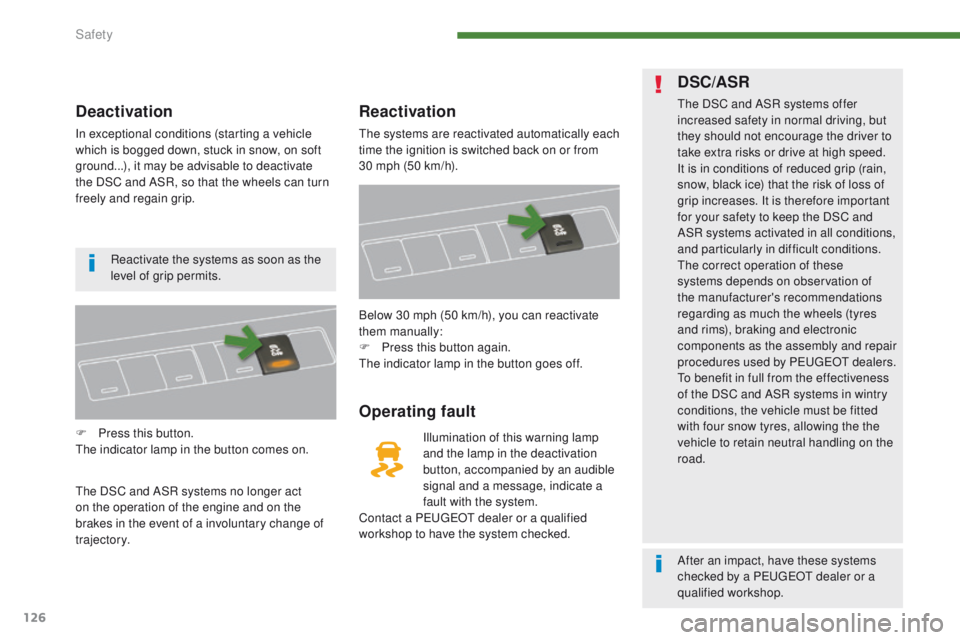
126
Deactivation
In exceptional conditions (starting a vehicle
which is bogged down, stuck in snow, on soft
ground...), it may be advisable to deactivate
the DSC and ASR, so that the wheels can turn
freely and regain grip.
F
P
ress this button.
The indicator lamp in the button comes on.
The DSC and ASR systems no longer act
on the operation of the engine and on the
brakes in the event of a involuntary change of
trajectory.
Reactivation
The systems are reactivated automatically each
time the ignition is switched back on or from
30
mph (50 km/h).
Operating fault
Illumination of this warning lamp
and the lamp in the deactivation
button, accompanied by an audible
signal and a message, indicate a
fault with the system.
Contact a PEUGEOT dealer or a qualified
workshop to have the system checked. Below 30 mph (50 km/h), you can reactivate
them manually:
F
P
ress this button again.
The indicator lamp in the button goes off.
DSC/ASR
The DSC and ASR systems offer
increased safety in normal driving, but
they should not encourage the driver to
take extra risks or drive at high speed.
It is in conditions of reduced grip (rain,
snow, black ice) that the risk of loss of
grip increases. It is therefore important
for your safety to keep the DSC and
ASR systems activated in all conditions,
and particularly in difficult conditions.
The correct operation of these
systems depends on observation of
the manufacturer's recommendations
regarding as much the wheels (tyres
and rims), braking and electronic
components as the assembly and repair
procedures used by PEUGEOT dealers.
To benefit in full from the effectiveness
of the DSC and ASR systems in wintry
conditions, the vehicle must be fitted
with four snow tyres, allowing the the
vehicle to retain neutral handling on the
road.
Reactivate the systems as soon as the
level of grip permits.
After an impact, have these systems
checked by a PEUGEOT dealer or a
qualified workshop.
Safety
Page 129 of 344
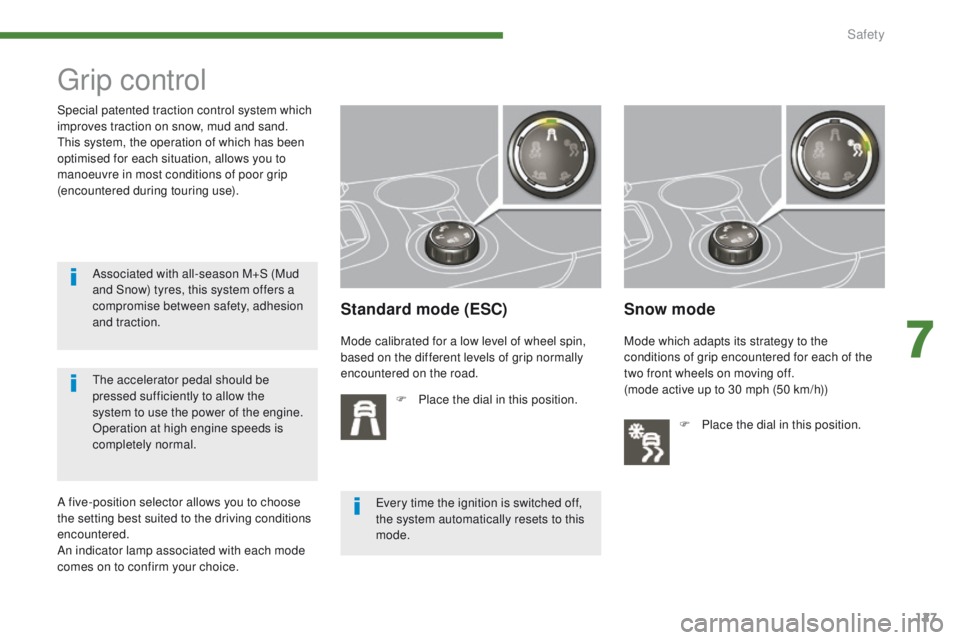
127
Grip control
Standard mode (ESC)
F Place the dial in this position.
Snow mode
Special patented traction control system which
improves traction on snow, mud and sand.
This system, the operation of which has been
optimised for each situation, allows you to
manoeuvre in most conditions of poor grip
(encountered during touring use).Mode calibrated for a low level of wheel spin,
based on the different levels of grip normally
encountered on the road.Mode which adapts its strategy to the
conditions of grip encountered for each of the
two front wheels on moving off.
(mode active up to 30 mph (50 km/h))
F
P
lace the dial in this position.
The accelerator pedal should be
pressed sufficiently to allow the
system to use the power of the engine.
Operation at high engine speeds is
completely normal.
Every time the ignition is switched off,
the system automatically resets to this
mode.
A five-position selector allows you to choose
the setting best suited to the driving conditions
encountered.
An indicator lamp associated with each mode
comes on to confirm your choice. Associated with all-season M+S (Mud
and Snow) tyres, this system offers a
compromise between safety, adhesion
and traction.
7
Safety
Page 130 of 344
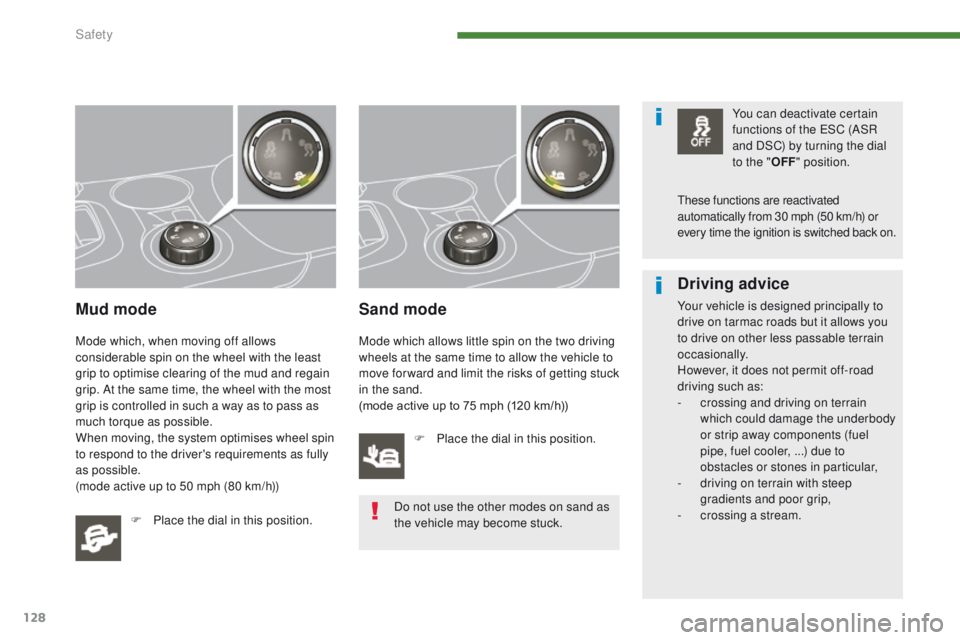
128
Mud mode
Mode which, when moving off allows
considerable spin on the wheel with the least
grip to optimise clearing of the mud and regain
grip. At the same time, the wheel with the most
grip is controlled in such a way as to pass as
much torque as possible.
When moving, the system optimises wheel spin
to respond to the driver's requirements as fully
as possible.
(mode active up to 50 mph (80 km/h))F
P
lace the dial in this position.
Sand mode
Mode which allows little spin on the two driving
wheels at the same time to allow the vehicle to
move for ward and limit the risks of getting stuck
in the sand.
(mode active up to 75 mph (120 km/h))F
P
lace the dial in this position. You can deactivate certain
functions of the ESC (ASR
and DSC) by turning the dial
to the "
OFF" position.
Driving advice
Your vehicle is designed principally to
drive on tarmac roads but it allows you
to drive on other less passable terrain
occasionally.
However, it does not permit off-road
driving such as:
-
c
rossing and driving on terrain
which could damage the underbody
or strip away components (fuel
pipe, fuel cooler,
...) due to
obstacles or stones in particular,
-
d
riving on terrain with steep
gradients and poor grip,
-
c
rossing a stream.
Do not use the other modes on sand as
the vehicle may become stuck. These functions are reactivated
automatically from 30 mph (50 km/h) or
every time the ignition is switched back on.
Safety
Page 131 of 344
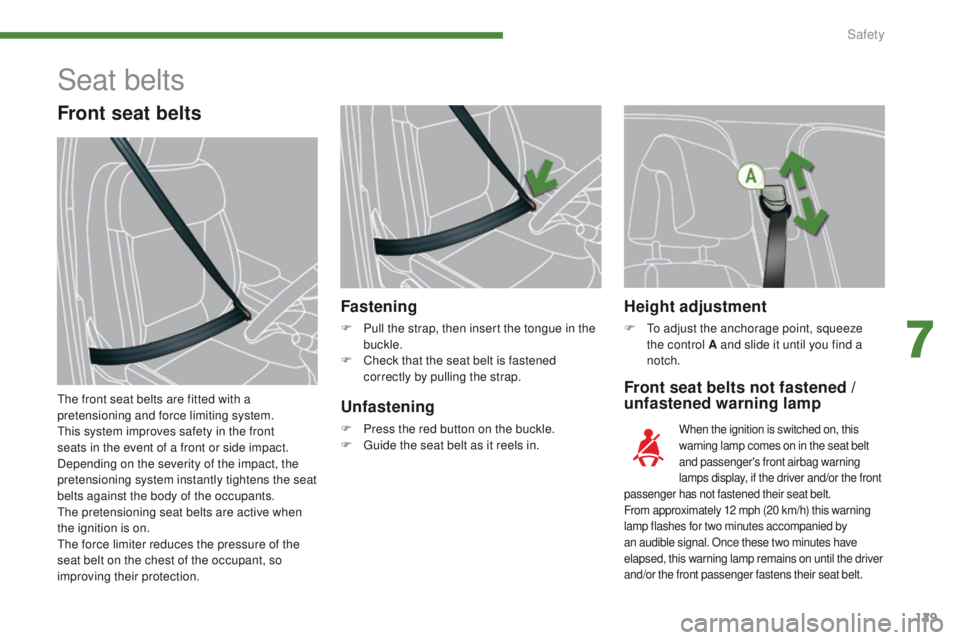
129
Height adjustment
F To adjust the anchorage point, squeeze the control A and slide it until you find a
notch.
Front seat belts not fastened /
unfastened warning lamp
Fastening
F Pull the strap, then insert the tongue in the
buckle.
F
C
heck that the seat belt is fastened
correctly by pulling the strap.
When the ignition is switched on, this
warning lamp comes on in the seat belt
and passenger's front airbag warning
lamps display, if the driver and/or the front
passenger has not fastened their seat belt.
From approximately 12 mph (20 km/h) this warning
lamp flashes for two minutes accompanied by
an audible signal. Once these two minutes have
elapsed, this warning lamp remains on until the driver
and/or the front passenger fastens their seat belt.
Unfastening
F Press the red button on the buckle.
F G uide the seat belt as it reels in.
Seat belts
Front seat belts
The front seat belts are fitted with a
pretensioning and force limiting system.
This system improves safety in the front
seats in the event of a front or side impact.
Depending on the severity of the impact, the
pretensioning system instantly tightens the seat
belts against the body of the occupants.
The pretensioning seat belts are active when
the ignition is on.
The force limiter reduces the pressure of the
seat belt on the chest of the occupant, so
improving their protection.
7
Safety
Page 132 of 344
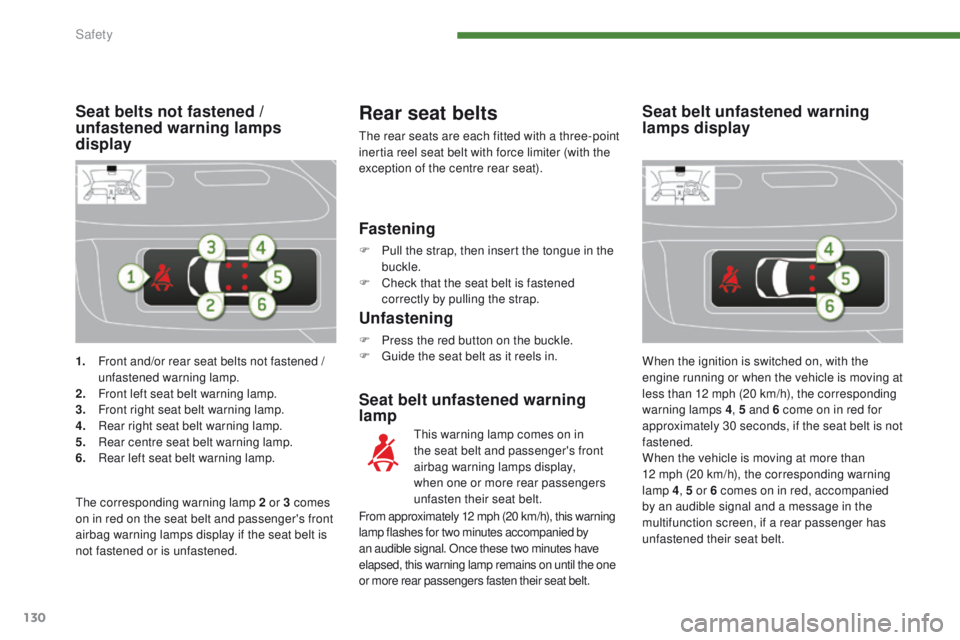
130
1. Front and/or rear seat belts not fastened / unfastened warning lamp.
2.
F
ront left seat belt warning lamp.
3.
F
ront right seat belt warning lamp.
4.
R
ear right seat belt warning lamp.
5.
R
ear centre seat belt warning lamp.
6.
R
ear left seat belt warning lamp.
Seat belts not fastened /
unfastened warning lamps
displayRear seat belts
The rear seats are each fitted with a three-point
inertia reel seat belt with force limiter (with the
exception of the centre rear seat).
Seat belt unfastened warning
lamp
This warning lamp comes on in
the seat belt and passenger's front
airbag warning lamps display,
when one or more rear passengers
unfasten their seat belt.
Fastening
F Pull the strap, then insert the tongue in the buckle.
F
C
heck that the seat belt is fastened
correctly by pulling the strap.
Unfastening
F Press the red button on the buckle.
F G uide the seat belt as it reels in.
The corresponding warning lamp 2 or 3 comes
on in red on the seat belt and passenger's front
airbag warning lamps display if the seat belt is
not fastened or is unfastened. When the ignition is switched on, with the
engine running or when the vehicle is moving at
less than 12 mph (20 km/h), the corresponding
warning lamps 4
, 5 and 6 come on in red for
approximately 30 seconds, if the seat belt is not
fastened.
When the vehicle is moving at more than
12
mph (20 km/h), the corresponding warning
lamp 4 , 5 or 6 comes on in red, accompanied
by an audible signal and a message in the
multifunction screen, if a rear passenger has
unfastened their seat belt.
Seat belt unfastened warning
lamps display
From approximately 12 mph (20 km/h), this warning
lamp flashes for two minutes accompanied by
an audible signal. Once these two minutes have
elapsed, this warning lamp remains on until the one
or more rear passengers fasten their seat belt.
Safety
Page 134 of 344
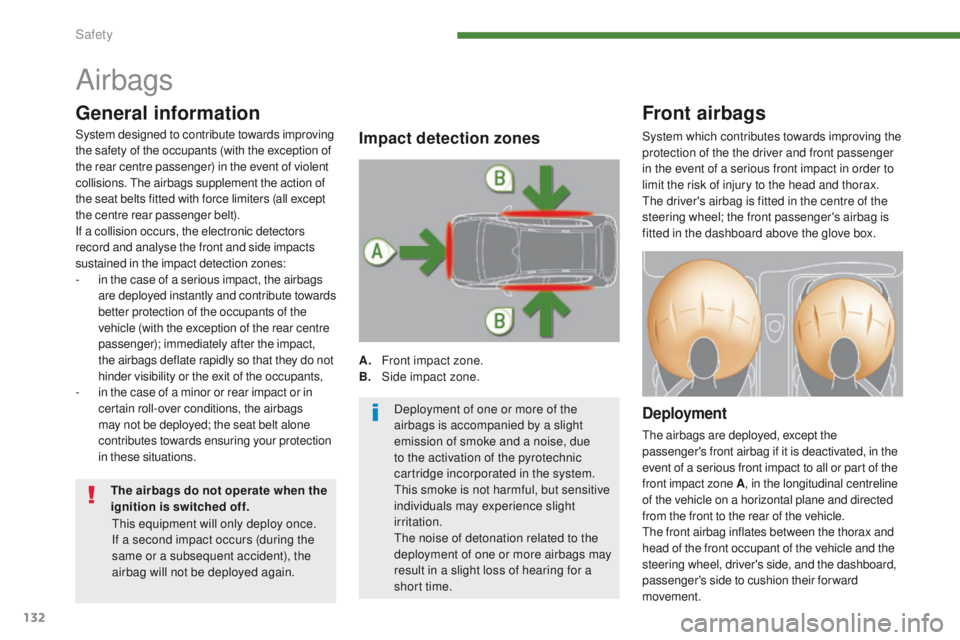
132
Airbags
Front airbags
Deployment
The airbags are deployed, except the
passenger's front airbag if it is deactivated, in the
event of a serious front impact to all or part of the
front impact zone A, in the longitudinal centreline
of the vehicle on a horizontal plane and directed
from the front to the rear of the vehicle.
The front airbag inflates between the thorax and
head of the front occupant of the vehicle and the
steering wheel, driver's side, and the dashboard,
passenger's side to cushion their forward
movement.
Impact detection zones
A. Front impact zone.
B. S ide impact zone.
General information
System designed to contribute towards improving
the safety of the occupants (with the exception of
the rear centre passenger) in the event of violent
collisions. The airbags supplement the action of
the seat belts fitted with force limiters (all except
the centre rear passenger belt).
If a collision occurs, the electronic detectors
record and analyse the front and side impacts
sustained in the impact detection zones:
-
i
n the case of a serious impact, the airbags
are deployed instantly and contribute towards
better protection of the occupants of the
vehicle (with the exception of the rear centre
passenger); immediately after the impact,
the airbags deflate rapidly so that they do not
hinder visibility or the exit of the occupants,
-
i
n the case of a minor or rear impact or in
certain roll-over conditions, the airbags
may not be deployed; the seat belt alone
contributes towards ensuring your protection
in these situations. System which contributes towards improving the
protection of the the driver and front passenger
in the event of a serious front impact in order to
limit the risk of injury to the head and thorax.
The driver's airbag is fitted in the centre of the
steering wheel; the front passenger's airbag is
fitted in the dashboard above the glove box.
Deployment of one or more of the
airbags is accompanied by a slight
emission of smoke and a noise, due
to the activation of the pyrotechnic
cartridge incorporated in the system.
This smoke is not harmful, but sensitive
individuals may experience slight
irritation.
The noise of detonation related to the
deployment of one or more airbags may
result in a slight loss of hearing for a
short time.
The airbags do not operate when the
ignition is switched off.
This equipment will only deploy once.
If a second impact occurs (during the
same or a subsequent accident), the
airbag will not be deployed again.
Safety
Page 135 of 344

133
Operating fault
If this warning lamp comes on,
accompanied by an audible
warning and a message, contact
a PEUGEOT dealer or a qualified
workshop without delay to have the system
checked. The airbags may no longer be
deployed in the event of a serious impact.
Reactivation
When you remove the rear ward facing child
seat, with the ignition off , turn the switch to
the "ON" position to reactivate the airbag and
so assure the safety of your front passenger in
the event of an impact.
When switching the ignition on,
this warning lamp comes on in the
seat belt and passenger's front
airbag warning lamps display for
approximately one minute, to signal
that the passenger's front airbag is
activated.
On switching on the ignition, this
warning lamp comes on in the
instrument panel and/or in the seat
belt and passenger's front airbag
warning lamps display. It stays on
until the airbag is reactivated.
Deactivation
Only the passenger's front airbag can be
deactivated.
F
W
ith the ignition off , insert the key in the
passenger airbag deactivation switch.
F
T
urn it to the "OFF" position.
F
T
hen, remove the key keeping the switch in
the new position. To assure the safety of your child,
the passenger's front airbag must be
deactivated when you install a rear ward
facing child seat on the front passenger
seat.
Otherwise, the child would risk being
seriously injured or killed if the airbag
were deployed.
7
Safety
Page 139 of 344
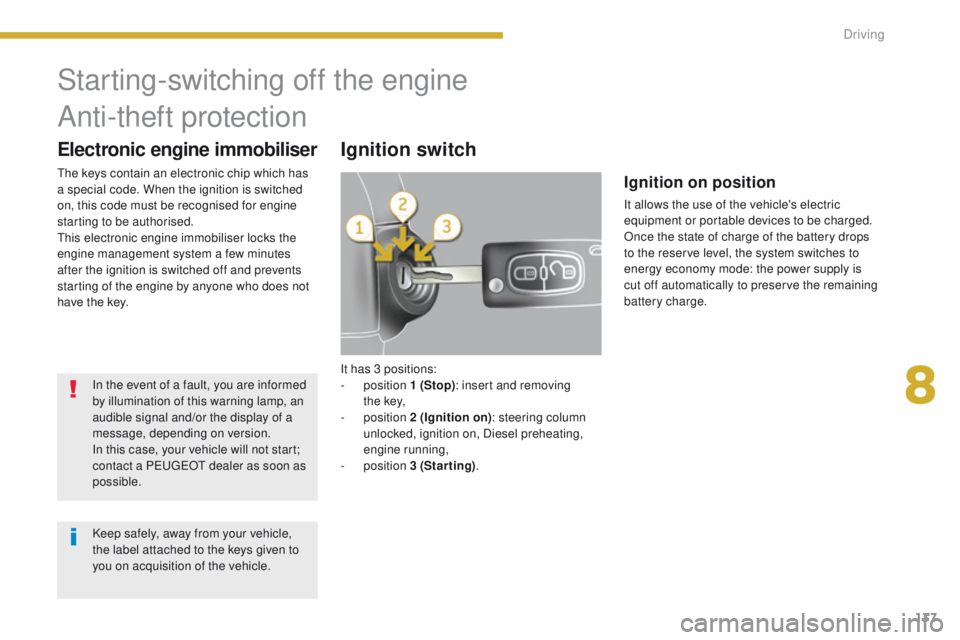
137
It has 3 positions:
- position 1 (Stop): insert and removing
t h e
key,
-
position 2 (Ignition on) : steering column
unlocked, ignition on, Diesel preheating,
engine running,
-
position 3 (Starting) .
Starting-switching off the engine
Ignition on position
It allows the use of the vehicle's electric
equipment or portable devices to be charged.
Once the state of charge of the battery drops
to the reserve level, the system switches to
energy economy mode: the power supply is
cut off automatically to preserve the remaining
battery charge.
Ignition switch
Anti-theft protection
Electronic engine immobiliser
In the event of a fault, you are informed
by illumination of this warning lamp, an
audible signal and/or the display of a
message, depending on version.
In this case, your vehicle will not start;
contact a PEUGEOT dealer as soon as
possible.
Keep safely, away from your vehicle,
the label attached to the keys given to
you on acquisition of the vehicle.
The keys contain an electronic chip which has
a special code. When the ignition is switched
on, this code must be recognised for engine
starting to be authorised.
This electronic engine immobiliser locks the
engine management system a few minutes
after the ignition is switched off and prevents
starting of the engine by anyone who does not
have the key.
8
Driving